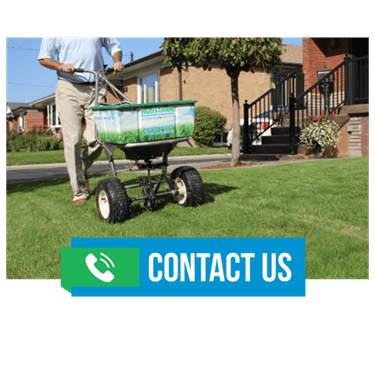6 min read
September 2024 Newsletter: Nova Scotia & Moncton
By: Steve Smith, Nutri-Lawn Halifax on Aug 16, 2024 8:39:56 AM

SEPTEMBER 2024
Your Account | Free Estimate | Resource Library | Agronomic Calendar
SLIT-SEEDING
 Slit-Seeding effectively repairs weak, bare, and thin areas of your lawn. The slit-seeder machine slices shallow, narrow, vertical rows into the soil and drops seed into those rows, simultaneously. These vertical rows are cut in multiple directions to encourage thick growth and repair. This ensures excellent seed-to-soil contact which optimizes seed germination and improves turf establishment.
Slit-Seeding effectively repairs weak, bare, and thin areas of your lawn. The slit-seeder machine slices shallow, narrow, vertical rows into the soil and drops seed into those rows, simultaneously. These vertical rows are cut in multiple directions to encourage thick growth and repair. This ensures excellent seed-to-soil contact which optimizes seed germination and improves turf establishment.
BENEFITS
- Ideal for damaged areas requiring renovation and/or for thin and bare spots.
- Provides excellent seed to soil contact.
- Optimizes seed germination and promotes quick establishment.
- Introduces new seed cultivars specialized to resist drought, insect, and disease pressures.
- Cost effective alternative to resodding.
- See the results in only a few short weeks!
EUROPEAN CRANE FLY
 The adult European crane fly has very long legs and looks like a large mosquito with a body length of 1 inch, not including the legs.
The adult European crane fly has very long legs and looks like a large mosquito with a body length of 1 inch, not including the legs.
Homeowners are often alarmed when thousands of these large flies gather in the lawn and/or on the sides of homes.
The larvae are a maggot called a leatherjacket, and are light grey to greyish, greenish brown, with irregular black specks of various sizes.
Leatherjackets go into a non-feeding stage just below the soil surface during July and August.
From late August through September pupae wriggle to the surface and the adult crane flies emerge.
Leatherjacket populations rarely exceed turfgrass injury thresholds. The crane flies are more of a nuisance and not a cause for concern.
LIQUID AERATION
 Liquid Aeration contains a naturally derived wetting agent, which acts as a soil penetrant, loosening hard pan and increasing the capillary action of water. This improves the porosity of the soil allowing water and nutrients to penetrate deeper.
Liquid Aeration contains a naturally derived wetting agent, which acts as a soil penetrant, loosening hard pan and increasing the capillary action of water. This improves the porosity of the soil allowing water and nutrients to penetrate deeper.
This method aims at improving soil structure and its physical properties including enhancing nutrient uptake and root development, improving water infiltration, and holding capacity, increasing rootzone oxygen exchange, and accelerates thatch accumulation breakdown.
The liquid aeration process creates microscopic pores in the soil that act as sponges.
The liquid application includes fulvic, humic, and salicylic acid, sea kelp, activated carbon, plant essential nutrients, and other bio-stimulants designed to strengthen and improve plant growth.
BENEFITS
- Provides 100% lawn coverage.
- No surface disruption / cores left on the lawn.
- Increased rooting and stress tolerance.
- Boost water infiltration and holding capacity.
- Longer lasting and cumulative results.
- Reduced noise pollution, associated with gas powered equipment.
- No risk of damage to irrigation systems, landscape lighting or underground wires.
RUST DISEASE
 Does the appearance of your lawn look orange or have your shoes turned a rusty orange colour after walking across the lawn?
Does the appearance of your lawn look orange or have your shoes turned a rusty orange colour after walking across the lawn?
If so, that is a good indication the lawn has been infected by a fungal disease called Rust. Rust disease is very common on most turf grass especially Kentucky Bluegrass and Perennial Ryegrass.
Environmental stresses contribute to the severity of the disease. When plants become diseased by the rust fungi, they are more susceptible to other diseases and stress. It can appear at any time during the growing season but is prevalent during late summer and autumn, when grass is growing slowly. Warm and dry conditions in combination with cooler nights and heavy dews, are ideal conditions for rust. Fortunately, rust is not a serious disease and rarely kills the grass.
SYMPTOMS
Turf may appear to be thin and discolored as individual shoots begin to die. Towards the end of the rust disease infection cycle, leaves may become shredded and point downward if the infection is severe enough.
MANAGEMENT STRATEGIES
Rust can be controlled with sound turf management. Promoting proper fertilization and maintaining the correct mowing height and frequency will reduce the rust and help the lawn recover quickly. Sufficiently irrigating in the early morning instead of in the late in the day, will also help improve your lawn.
Mowing on a regular basis and keeping the mowing height at recommended levels can help reduce the instances of disease. When cooler weather and the autumn growth spurt hits, the grass will typically recover on its own.

 Nutri-Lawn
Nutri-Lawn
Bridgewater: 902.527.0007
Halifax: 902.468.8101
Kentville: 902.681.2654
Moncton: 506.857.9111
New Glasgow: 902.601.5046
Truro: 902.893.2099
1-888-688-7452



